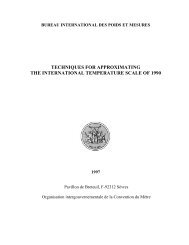On the measurement quality of UTC time transfer - BIPM
On the measurement quality of UTC time transfer - BIPM
On the measurement quality of UTC time transfer - BIPM
Create successful ePaper yourself
Turn your PDF publications into a flip-book with our unique Google optimized e-Paper software.
Notation AND ABBREVIATIONS:<br />
GUM 1 : ‘Evaluation <strong>of</strong> <strong>measurement</strong> data - Guide to <strong>the</strong> expression <strong>of</strong> uncertainty in <strong>measurement</strong>’, JCGM (Joint<br />
Committee for Guides in Metrology) 100:2008 [3]<br />
Link: Time-<strong>transfer</strong> link. The result is <strong>the</strong> clock comparison between two laboratories<br />
dL: Time link difference between two Links 1 and 2 <strong>of</strong> a common clock baseline: dL = Link1 – Link2<br />
uA: The Type A standard uncertainty in a ‘link’ as defined between February 2004 and November 2011 and<br />
evaluated in Section 6 <strong>of</strong> <strong>BIPM</strong> Circular T 194-286 [1]. Because it dominates <strong>the</strong> Type A uncertainty in [<strong>UTC</strong>-<br />
<strong>UTC</strong>(k)] and is <strong>the</strong>refore <strong>the</strong> key concept discussed in this paper<br />
uA ’ : The present estimation <strong>of</strong> uA as defined and evaluated in Section 6 <strong>of</strong> Circular T 287 and since December<br />
2011 [20]<br />
uA”: Standard uncertainty <strong>of</strong> dL defined as uA”=√[uA²(Link1) + uA²(Link2)]. It serves in this paper as a criterion<br />
<strong>of</strong> <strong>the</strong> tolerance for <strong>the</strong> outliers in <strong>the</strong> dL<br />
σ: Standard deviation <strong>of</strong> <strong>the</strong> dL<br />
σ: Standard deviation <strong>of</strong> <strong>the</strong> Vondrak smoothing residuals <strong>of</strong> a link<br />
TDev/τ: Time Deviation corresponding to <strong>the</strong> averaging <strong>time</strong> τ indicating <strong>the</strong> flicker PM segment [9,10]<br />
YYMM: Year and month <strong>of</strong> a particular <strong>UTC</strong> computation month, e.g. 1101 stands for January 2011.<br />
TW: TWSTFT, Two-Way Satellite Time and Frequency Transfer<br />
AV: All in View <strong>time</strong> <strong>transfer</strong> [13,14]<br />
CV: Common View <strong>time</strong> <strong>transfer</strong><br />
GPS: US Global Positioning System<br />
GLN: GLONASS, Russian Global Navigation Satellite System<br />
GPSGLN: Combination <strong>of</strong> GPS C/A and GLN L1C codes [6]<br />
SC: Single channel GPS<br />
MC: Multi-channel GPS or GLN receiver<br />
P3: Ionosphere-free code obtained with <strong>the</strong> linear combination <strong>of</strong> <strong>the</strong> two precise codes P1 and P2 [7]<br />
PPP: Time and frequency <strong>transfer</strong> using <strong>the</strong> Precise Point Positioning method [8]<br />
CP: Carrier phase. Used to obtain <strong>the</strong> GPS PPP<br />
TWPPP: Combination <strong>of</strong> TW and CP [5]<br />
HM: Hydrogen-Maser<br />
1. Introduction<br />
According to <strong>the</strong> report from JCGM 100:2008 [3], <strong>the</strong> total uncertainty in a measurand can be considered to<br />
consist <strong>of</strong> two parts [11,12]: <strong>the</strong> Type A component (uA) which is estimated by statistical means, and <strong>the</strong> Type B<br />
component (uB) estimated by o<strong>the</strong>r methods.<br />
In <strong>the</strong> case <strong>of</strong> <strong>UTC</strong>, <strong>the</strong> dominant contributions to both <strong>the</strong> Type A and Type B uncertainties <strong>of</strong> [<strong>UTC</strong>-<strong>UTC</strong>(k)]<br />
relate to <strong>the</strong> <strong>time</strong> links [<strong>UTC</strong>(k)–<strong>UTC</strong>(PTB)] 2 . The evolution, and <strong>the</strong>refore <strong>the</strong> evaluation, <strong>of</strong> <strong>the</strong> uncertainty in<br />
[<strong>UTC</strong>-<strong>UTC</strong>(k)] corresponds almost exactly to that in <strong>the</strong> <strong>time</strong>-<strong>transfer</strong> techniques, although <strong>the</strong> clock weighting<br />
strategy in <strong>the</strong> algorithm <strong>of</strong> <strong>UTC</strong> generation also has some limited impact on uncertainty propagation [12].<br />
Taking examples from Circular T 287 [20], <strong>the</strong> Type A uncertainties <strong>of</strong> [<strong>UTC</strong>-<strong>UTC</strong>(k)] and <strong>of</strong> <strong>the</strong> links<br />
[<strong>UTC</strong>(k)–<strong>UTC</strong>(PTB)] differ by no more than 0.1 ns (see Table 1). The same is true for uB. uB is not discussed in<br />
this paper.<br />
1<br />
GUM 1993, GUM 1995 and JCGM 100:2008 are different editions <strong>of</strong> <strong>the</strong> same document [4].<br />
2<br />
After <strong>the</strong> introduction <strong>of</strong> <strong>the</strong> AV in 2006, all <strong>UTC</strong>(k) are linked directly with PTB (Physikalisch-Technische Bundesanstalt), i.e. [<strong>UTC</strong>(k)–<br />
<strong>UTC</strong>(PTB)], cf. <strong>the</strong> Annex.<br />
3
















